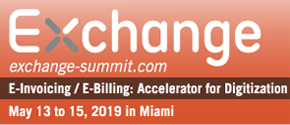I recently had the opportunity to connect with Iris Martinez, Delivery of Services and Technology Director for Latin America, based in Mexico, for Pearson, about her experiences and lessons learned from implementing e-Invoicing in Latin America (LATAM). Iris will be presenting a user case study on this topic on May 15th at the Exchange Summit Conference in Miami, and I thought this would be a great opportunity for our community to hear how Pearson approached this challenge and the success they were able to achieve.
Bob Cohen: Thank you for taking the time to connect with Ardent Partners. Let’s jump right in. Can you please tell me what led you to implement e-Invoicing for Pearson in Mexico?
Iris Martinez: At Pearson, we are always looking for alternatives in every area of the business that allow us to improve our processes and solutions to become simpler and more efficient. When we decided to include e-invoicing as part of the automation process in Mexico, we saw the possibilities that electronic documents could offer for the company, not only to comply with mandatory requirements, but also to allow us to speed up the interaction of every participant in the P2P cycle and eliminate inefficient, costly paper processes. Mexico was selected as the initial country for an e-Invoicing rollout in the region. And, as an important market in Latin America, if the solution was successfully delivered in Mexico, the approach could be extended to other countries across the region with a standardized proposal.
BC: How did you go about implementing e-Invoicing in LATAM?
IM: After the project was successfully delivered in Mexico, we decided to implement e-invoicing elsewhere in the region. We evaluated what could be useful in other countries and took that knowledge to help roll out e-Invoicing. There were many consideration we had to take into account including the lack of a universal standard for invoice content, technical challenges from country to country, non-standardized systems, as well as cultural differences in the region that are always present even though we may all speak the same language. Our approach was to consider that a process might be the same in general terms but would have to accommodate local needs. The entire organization needed to be involved, always keeping in mind the project objective of making the invoicing process more efficient overall. In general terms, our implementation focused first on analyzing the business needs of each country, the customers and suppliers we worked with in each country, and a clear definition of requirements. We then built a business case for the implementation, established a clear time frame for the project and, of course, allocated budget to work with.
BC: Supplier Onboarding is critical in any e-Invoicing project. What challenges did you face and what lessons did you learn along the way?
IM: Identifying the proper business partner to help you with the planning, implementation and execution of the project is a key element to succeed. Pearson is not in the e-invoicing business; our business is to deliver the best learning solutions to customers. In as much we required a robust supplier with certified experience, commitment and presence in the countries of our project scope to deliver this type of initiative. We faced difficulties that made us think with a global perspective but to act with a local mindset. We learned the individual requirements of each country and adapted the process to cover and comply with their local needs while also considering the size of the business unit, maturity of systems, and mandatory content. Support was a key requirement for this project so we had to ensure we had selected the right external integration partner to work with our internal staff on the initiative.
BC: What benefits have you received from your e-Invoicing implementation?
IM: We became more efficient and effective by implementing e-invoicing. We extended the processes and technology used for e-invoicing to other e-documents (purchase orders, payments, receipts, samples, etc.) and consolidated them in a single solution (place) where everything is readily accessible. By automating the invoice process and e-invoice generation, we were able to reduce the cost per (paper) invoice by 40%! Control and visibility is improved as we now have the tools to automatically manage all e-documents. We also built strong synergies with a business partner that provided us with the latest technology and solutions to help improve our processes.
BC: What’s next for Pearson? What future projects are on the horizon?
IM: We will continue delivering e-documents in LATAM with the technology we implemented for this project. We also plan to bring different solutions like Robotic Process Automation (“RPA”) to the region, and continue to look for ways to improve our operations. Our ultimate goal is to leverage the latest technology to provide internal and external services and solutions that support Pearson’s overall business objective of delivering the best learning experiences for its customers.
BC: Thank you for sharing your experiences with our community, and best of luck on your upcoming presentation at the Exchange Summit in Miami.








Comments are closed.